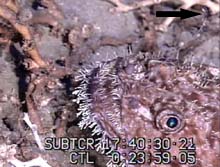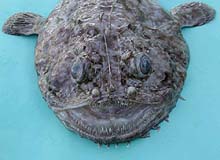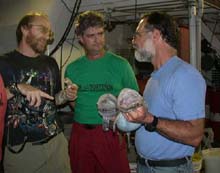
Dr. John Caruso (right) shows two anglerfish specimens caught during a submersible dive to fellow scientists Steve Ross (left) and George Dennis (middle). Both specimens belong to the Lophiidae family. Click image for larger view.
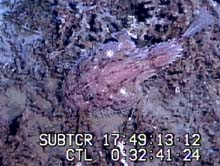
The anglerfish's flat shape and coloration make it difficult to distinguish from the surrounding coral as it rests on the sea floor. Click image for larger view.
Interview with Dr. John Caruso:
The Anglerfish Advocate
September 25, 2001
![]() View a video of anglerfish in a defensive posture. (2.3 MB, QuickTime
View a video of anglerfish in a defensive posture. (2.3 MB, QuickTime ![]() required).
required).
Ocean Explorer: You are a professor in the Department of Biological Sciences at the University of New Orleans. What type of research do you do?
Dr. Caruso: My research focuses on the systematics of deep-sea anglerfishes. Systematics is a branch of taxonomy, the subdivision of biology that deals with the discovering, naming, and classifying of organisms. In systematics, we try to construct classifications that reflect or portray phylogenetic (evolutionary) relationships. Specifically, I work on the systematics of two anglerfish families, the one we got on this cruise, Lophiidae (also known as monkfishes or goosefishes) and the Chaunacidae. Chaunacids really don't have a common name in this country. In some other parts of the world, they are called sea toads or coffin fishes. The latter probably alludes to their shape.
In a sense, what I do is part of what Drs. Steve Ross and Ken Sulak do. We discover new species of fishes, give them names, and try to classify them in a way that reflects their phylogenetic relationships. I have described a new genus and eight new species of marine fishes, some lophiids, some chaunacids, and one giant (6-7 ft long) ophichthid, commonly known as a snake eel.
Ocean Explorer: What is the difference between a lophiid and a chaunacid?
Caruso: They are different anglerfish families. In fact, they are actually in different suborders of the anglerfish order Lophiiformes. Chaunacids are pink in coloration, have loose skin with very small, spine-like scales, and are rounded in cross-section. The angling apparatus is very short in chaunacids and has a peculiar, mop-like bait. They have smaller teeth and are generally smaller in size than lophiids. A big chaunacid is about a foot long. Chaunacids generally live in deeper water. One species I described, from off Madagascar, is known to inhabit depths of at least 2,580 m (8,385 ft).
Lophiids are variable in coloration, and many have the ability to mimic their surroundings, like many flounders do. They have smooth, loose, scaleless skin, and are generally flattened. The lophiid angling apparatus is usually very long and slender, and has a simple bulb or pennant-like bait. In some species the bait may be luminescent, while in others it may mimic a small, shrimp-like organism, even to the extent of having dark, stalked eye-like appendages. Lophiids are generally larger than chaunacids; the lophiid genus Lophius contains two species that can grow over 4 ft long, and one, the European monkfish (Lophius piscatorius), is said to reach 6 ft. The Atlantic monkfish or goosefish (Lophius americanus) reaches a total length of around 4 ft. Chaunacids and lophiids also differ osteologically (with regard to the details of their skeletal structure).
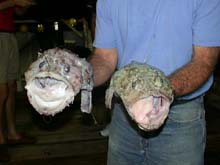
Dr. Caruso holds two anglerfish specimens caught during a submersible dive. On the left is Lophiodes beroe; on the right is Lophiodes monodi. Click image for larger view.
Ocean Explorer: What is your role and interest in this mission?
Dr. Caruso: My interest is in the distribution and ecology of marine fishes, primarily deep-sea species. I came along on this trip hoping that I would see some anglerfishes, and the trip has exceeded all my expectations. I’ve seen two species that weren't known to occur here, one of which (Lophiodes beroe) I described. As far as my specific role, I’ve served as watch chief. Dr. Steve Ross told me that he wanted someone with my collecting and deep-water trawling experience. I also have experience identifying fishes from the continental shelf and slope.
It's the watch chief's responsibility to carry out the scientific mission of the expedition during his or her assigned watch. This involves coordinating operations between the chief scientist, the vessel crew, and the other members of the scientific crew on watch. Within constraints imposed by the chief scientist and the captain, this even includes making decisions about where the ship goes.
Ocean Explorer: How does this area compare with areas you have explored in the Gulf of Mexico?
Dr. Caruso: The northern Gulf has a muddier bottom, and water temperatures, both surface and bottom, are much warmer. The fish fauna is very similar, at least in the deeper water. Once you get into shallower water, it’s a little more distinct, but similarities still exist. There are probably more similarities between the ichthyofauna (fish species) in the Gulf of Mexico and the southern Atlantic south of Hatteras than there are between Hatteras and Cape Cod. So it’s not really as different as you might think.
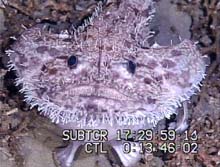
![]() In an attempt to intimidate the submersible, this anglerfish (Lophiodes beroe) expanded its gill chambers and raised itself on its pelvic fins to look bigger. Click image to watch this "cocky" bottom-dweller challenge the sub.
In an attempt to intimidate the submersible, this anglerfish (Lophiodes beroe) expanded its gill chambers and raised itself on its pelvic fins to look bigger. Click image to watch this "cocky" bottom-dweller challenge the sub.
Ocean Explorer: What are you going to do with the two lophiid specimens you have collected on this cruise?
Dr. Caruso: I will probably write a short paper with Drs. Sulak and Ross discussing several things we learned about the biology of the two Lophiodes species we collected with the Johnson Sea-Link submersible, including the fact that they were not known to inhabit the U.S. Atlantic Coast. In fact, my first contact with Dr. Ross, about 25 yrs ago, was documenting the first occurrence in these waters of another member of that genus that I named (Lophiodes reticulatus). Now we have found the other two Atlantic members of that genus, which were previously unknown to occur north of the Straits of Florida. That’s quite interesting. Also, these specimens are the two largest members of the genus ever collected in the world, to the best of my knowledge. I have probably examined close to 1,000 lophiid specimens, and I think I can say with some degree of certainty that they are the largest known representatives of the genus Lophiodes.
Ocean Explorer: What else is interesting about these fish?
Dr. Caruso: Anglerfish get their name from a very unusual adaptation. The front portion of the dorsal fin has moved forward, near the tip of the snout, and the first spine has become modified as an angling apparatus (illicium) that even bears a small "bait" (esca) at its tip. The anglerfish lies in wait, motionless, until suitable prey approaches. When the prey is near, it raises its angling apparatus and wiggles it vigorously. When the prey approaches to inspect the activity, the anglerfish opens its mouth with lightning speed, engulfing the prey in a matter of milliseconds. This angling behavior is one of the reasons why the anglerfish are among the most successful fishes in the deep sea. They don’t waste energy chasing down other fish! Instead, they sit still and wiggle that one little fin spine, which requires only a very small muscle instead of the huge axial muscles required for swimming. So, they conserve energy in an energy-poor environment.
The life history of lophiid anglerfishes is also quite interesting. They are benthic (bottom-dwelling) fishes with limited powers of mobility. They are not good swimmers -- in fact, they swim only a little bit better than a brick! All kidding aside, they have very limited powers of locomotion. Instead, they rely on their larvae for geographic distribution. The larvae are pelagic; that is, they are suspended in the water column. The adults lay eggs in a unique fashion, unknown among other fishes. The eggs are contained in a gigantic gelatinous veil, which, in the case of the North Atlantic monkfish, Lophius americanus, can be up to 12 m long and 1.5 m wide. The egg mass hydrates as it enters the water, swelling to a volume many times greater than its size within the female. The ocean currents carry the egg veil, and then the larvae after they hatch, spreading the larvae over wide areas. When the larvae transform and acquire adult characteristics, they "settle out" to life on the bottom.
In addition to the increased difficulty in finding food in the deep sea, it is also difficult to find a mate. Anglerfish have some interesting adaptations that aid in "matchmaking." You may have noticed on one of the specimens we collected that the male had greatly enlarged olfactory organs. That’s how you distinguish the males from the females. The male uses these organs to locate females, which presumably emit a chemical signal, called a pheromone, to attract the male.
Perhaps most interesting of all, the midwater anglerfishes (ceratioids) have the most pronounced sexual dimorphism (size difference) in the animal kingdom. The males are reduced to tiny little parasites that hang onto the female. That way, the female never has to look for a mate, because they actually live "on" her. They even achieve histological fusion (i.e., the male dies if separated from the female), which, to my knowledge, is unique in the animal world. The male is parasitic, and essentially nothing more than a self-propelled pair of gonads directed by a nose. Not all anglerfish have this adaptation, but several families do.
Ocean Explorer: What are your plans for future research?
Dr. Caruso: I'm still doing systematic research on the both the chaunacids and lophiids. I have published several papers that constitute a worldwide revision of lophiids, and also a couple of papers on chaunacids, including a revision of the Atlantic species. I’m further along in understanding the systematics of the lophiid anglerfishes than I am with the chaunacids, but much work remains to be done on both of these fascinating fish families.
Sign up for the Ocean Explorer E-mail Update List.












































